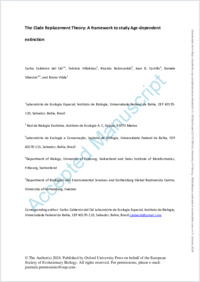The Clade Replacement Theory: A framework to study Age-dependent extinction
DOKPE
- Calderón del Cid, Carlos ORCID Universidade Federal da Bahia, Salvador, Bahia, Brasil
- Villalobos, Fabricio ORCID Instituto de Ecología A. C, Xalapa, Mexico
- Dobrovolski, Ricardo ORCID Universidade Federal da Bahia, Salvador, Bahia, Brazil
- Carrillo, Juan D. ORCID University of Fribourg
- Silvestro, Daniele ORCID University of Fribourg
- Vilela, Bruno ORCID Universidade Federal da Bahia, Salvador, Bahia, Brasil
- 2024
Published in:
- Journal of Evolutionary Biology. - Wiley. - 2024
English
There is no scientific consensus about whether and how species’ evolutionary age, or the elapsed time since their origination, might affect their probability of going extinct. Different age-dependent extinction (ADE) patterns have been proposed in theoretical and empirical studies, while the existence of a consistent and universal pattern across the tree of life remains debated. If evolutionary age predicts species extinction probability, then the study of ADE should comprise the elapsed time and the ecological process acting on species from their origin to their extinction, or to the present for extant species. Additionally, given that closely related species share traits associated with fitness, evolutionary proximity could generate similar ADE patterns. Considering the historical context and extinction selectivity based on evolutionary relatedness, we build on previous theoretical work to formalize the Clade Replacement Theory (CRT) as a framework that considers the ecological and evolutionary aspects of species age and extinction probability to produce testable predictions on ADE patterns. CRT’s domain is the diversification dynamics of two or more clades competing for environmental space throughout time; and its propositions or derived hypotheses are: i) incumbency effects by an early arriving clade that limit the colonization and the diversification of a younger clade leading to a negative ADE scenario (younger species more prone to extinction than older ones), and, ii) an ecological shift triggered by an environmental change that imposes a new selective regime over the environmental space and leads to a positive ADE scenario (extinction probability increasing with age). From these propositions, we developed the prediction that the ADE scenario would be defined by whether an ecological shift happens or not. We discuss how the CRT could be tested with empirical data and provide examples where it could be applied. We hope this paper will provide a common ground to unify results from different fields and foster new empirical tests of the mechanisms derived here while providing insights into CRT theoretical structuration.
- Faculty
- Faculté des sciences et de médecine
- Department
- Département de Biologie
- Language
-
- English
- Classification
- Biotechnology
- License
-
License undefined
- Open access status
- green
- Identifiers
-
- DOI 10.1093/jeb/voae012
- ISSN 1420-9101
- ISSN 1010-061X
- Persistent URL
- https://folia.unifr.ch/unifr/documents/327496
Statistics
Document views: 114
File downloads:
- calderondelcidetal2024crt_ade: 89
